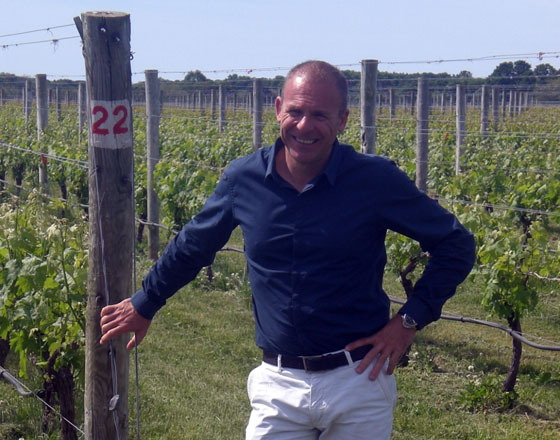
For the second year in a row the six members of the Long Island Merlot Alliance hired a noted Bordeaux oenologist, this time Stéphane Toutoundji, to visit each member vineyard, winery and lab. He arrived on Monday, June 3.
The Alliance is comprised of six local producers — Clovis Point in Jamesport, McCall Wines in Cutchogue, Raphael in Peconic, Sherwood House Vineyards in Jamesport, T’Jara Vineyards in Mattituck and Wölffer Estate Vineyard in Sagaponack.
Toutoundji has been making wine since 1988 and once was a student of the famous oenoligist, Michel Rolland. In 2002 Stéphane purchased half of the wine lab, Filles Pauquet in Libourne. Today he consults with almost 300 properties — mainly in France — but also in countries such as Portugal and Turkey.
This was Stéphane’s first visit to Long Island and his first time tasting Long Island wines.
I had the opportunity to sit down with Stéphane on the last day of his visit and talk to him about what he found in local vineyards, cellars and bottles.
The Long Island Merlot Alliance paid Stéphane’s way, so much of his advice and observations are meant only for members, but there are a few things Stéphane could share — and as we chatted looking out over the vines at Raphael, his enthusiasm for Long Island Wines and for what he had seen in his brief trip here was obvious.
Stéphane was impressed by the fruit-forward expression of the wines he tasted, which included bottles and barrel samples from 2005 through 2012. That seven-year window gave him an excellent insight into the vintage variation that local wineries have to deal with. He told me that enjoyed the traditional methods that the winemakers employ in the cellar here, finding the wines balanced, distinctive and delicious — though not very concentrated. He also shared that he found the oak, fruit and tannins were well integrated.
After tasting some older wines, for example, Wolffer Estate Vineyard 2001 Premier Cru, Stéphane believes that Long Island wines have the ability to age, saying that he has no doubt that Long Island Wines can age with the “best of the best.”
Not everything is perfect here, however. His biggest concern is one of the things wineries have no control over — the weather. The September and October rain we sometimes are obvious in some of the wines. It’s difficult to avoid mother nature and the wrath she can bring, but he would suggest new and interesting methods to help with this, almost unavoidable issue. “When you have heavy amounts of rain so close to harvest time, the roots will absorb the water” Stéphane said. He went on to say that, “the water moves into the berries and can cause them to swell and burst.” When this happens, any concentration of flavors that have developed in the berries themselves is lost.
Stéphane recommends that vineyards install drainage systems at the root base to combat this problem. This was a surprising recommendation given how well our sandy soils are purported to drain.
Some winemakers that I spoke to about this recommendation seemed to take it with a grain of salt, but perhaps it would be considered for new plantings?
Stéphane also cautioned growers and winemaker about when they pick — telling something that might seem obvious: You do not want to pick too soon and you most definitely do not want to pick when the fruit is over ripe. Some of the wines he tasted showed qualities consistent with over ripe-fruit — meaning the fruit had been left hang on the vines too long.
The few member winemakers that I spoke with felt positively about Stephane’s visit. They felt that his recommendations were helpful for member winemakers and that his suggestions would be looked at and taken into consideration. Anthony Nappa, the new winemaker at Raphael told me in an email ” Stephane’s visit was good and it is always very helpful to have professional opinions. Without an outside voice looking critically at what you are doing often times you can head off on a tangent. That is not necessarily good. In wineries, we call this a “house palate” where you may accentuate even bad flavors or practices just because you get used to them.”
Stéphane enjoyed the enthusiasm of the owners. Their understanding of the market and how to move their wine. He enjoyed the tasting rooms. He said that in Bordeaux, this is something that can be overlooked. Some proprietors there can sell a wine with out a single marketing tool, on Long Island, they seem to get it and they understand the market. This was one area that Nappa valued Stephane’s opinions, “One thing that I liked about his opinions was a focus on the business side of things, the wines profitability, price points and cash flow as well as quality. Its easy for a consultant to just tell you to spend more money on new equipment and practices.”
After tasting an array of wines, mostly red with some rose, Stéphane feels that merlot is perfect for this region, saying that the examples he tasted all showed well. And the Bordeaux blends, while they may not be able to sell in France, would surprise and raise a few eyebrows.
What does Stéphane see in Long Island’s future? “Long Island and merlot has a bright future. This region will be a destination that will increase in years to come.”

